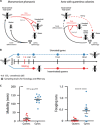The gene expression network regulating queen brain remodeling after insemination and its parallel use in ants with reproductive workers
- PMID: 32938672
- PMCID: PMC7494347
- DOI: 10.1126/sciadv.aaz5772
The gene expression network regulating queen brain remodeling after insemination and its parallel use in ants with reproductive workers
Abstract
Caste differentiation happens early in development to produce gynes as future colony germlines and workers as present colony soma. However, gynes need insemination to become functional queens, a transition that initiates reproductive role differentiation relative to unmated gynes. Here, we analyze the anatomy and transcriptomes of brains during this differentiation process within the reproductive caste of Monomorium pharaonis Insemination terminated brain growth, whereas unmated control gynes continued to increase brain volume. Transcriptomes revealed a specific gene regulatory network (GRN) mediating both brain anatomy changes and behavioral modifications. This reproductive role differentiation GRN hardly overlapped with the gyne-worker caste differentiation GRN, but appears to be also used by distantly related ants where workers became germline individuals after the queen caste was entirely or partially lost. The genes corazonin and neuroparsin A in the anterior neurosecretory cells were overexpressed in individuals with reduced or nonreproductive roles across all four ant species investigated.
Copyright © 2020 The Authors, some rights reserved; exclusive licensee American Association for the Advancement of Science. No claim to original U.S. Government Works. Distributed under a Creative Commons Attribution NonCommercial License 4.0 (CC BY-NC).
Figures






References
-
- W. M. Wheeler, Ants: Their Structure, Development and Behavior (Columbia Univ. Press, 1910), vol. 9.
-
- Hughes W. O. H., Oldroyd B. P., Beekman M., Ratnieks F. L. W., Ancestral monogamy shows kin selection is key to the evolution of eusociality. Science 320, 1213–1216 (2008). - PubMed
-
- Fisher R. M., Cornwallis C. K., West S. A., Group formation, relatedness, and the evolution of multicellularity. Curr. Biol. 23, 1120–1125 (2013). - PubMed
-
- Alvarado S., Rajakumar R., Abouheif E., Szyf M., Epigenetic variation in the Egfr gene generates quantitative variation in a complex trait in ants. Nat. Commun. 6, 6513 (2015). - PubMed
-
- Johnson B. R., Linksvayer T. A., Deconstructing the superorganism: Social physiology, groundplans, and sociogenomics. Q. Rev. Biol. 85, 57–79 (2010). - PubMed
Publication types
MeSH terms
LinkOut - more resources
Full Text Sources
Miscellaneous

